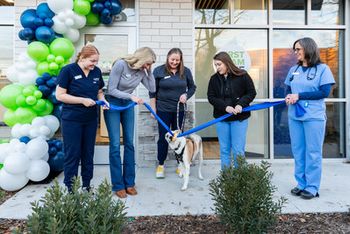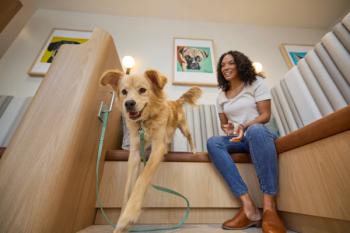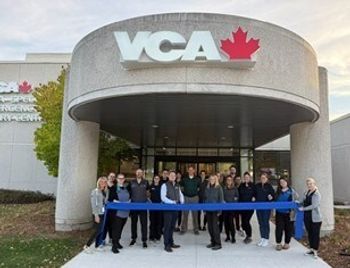
Catering to feline fancies
At Cat Clinic of Destin, cats are considered top dog, and Dr. Dorothy Flynn designed her Florida hospital to accommodate feisty felines and their occasionally finicky owners.
By Carolyn Chapman, Special Assignments Editor
Dr. Dorothy Flynn keeps a secret from her cats-only clients: She really likes dogs. But when she opened Cat Clinic of Destin in Destin, Fla., after 18 years in practice, she opted to focus exclusively on cats. The decision allowed her luxuries few "mixed" small animal practices offer: two boarding rooms with large cat condos; fewer concerns about noise; and the option to choose painted wood baseboards and vinyl flooring throughout without worrying about wear. The plan also proved a good marketing strategy for the new doctor in town. "There weren't any other exclusively feline hospitals in our area, so I wasn't competing head-to head with established veterinarians," Dr. Flynn says.
The judges of Veterinary Economics' 2001 Hospital Design Competition recognized the leasehold facility's excellent small plan. One competition judge remarked, "The hospital features a well-thought-out floor plan with clear traffic patterns." Another appreciated the facility's calm interior colors.
Patience pays off
Dr. Flynn spent 18 years working as an associate and as a relief veterinarian in several practices in Marietta, Ga., a suburb of Atlanta, and raising three children. She dreamed of owning a veterinary hospital, but she wasn't quite ready to jump into practice ownership--until her husband sold his business and the family moved to Destin. "We had vacationed here frequently and chose the area because it provided a nice coastal lifestyle," says Dr. Flynn, a 1982 University of Georgia graduate. "It's a great place to raise children."
The move cleared the way for Dr. Flynn to realize her dream, and she dived into the building experience, scouting for prime space in the small beach community. She found the perfect location in a new shopping center. A rough demographic survey revealed no veterinarians within a five-mile radius and no feline-only hospitals. The shopping center's location along the main road would draw clients from the east and west, its location near the Mid-Bay bridge would attract clients from the north, and she anticipated retail anchor tenants. "Several clients now drop off their cats before shopping," Dr. Flynn says.
The shopping center featured 1,000-square-foot shells that included a concrete floor, a drop ceiling, three walls, basic plumbing, and heating and cooling ductwork. Dr. Flynn wanted to lease two adjacent bays, but the developer balked, revealing that an anchor tenant specified no veterinary hospitals in its contract. After several letters and discussions, Dr. Flynn finally made the tenant understand that barking dogs and sidewalk messes wouldn't be an issue because she only treated cats. The developer then leased her the space.
Dr. Flynn drew on her experience working in a variety of veterinary facilities to design her basic floor plan. She says she and her husband spent many afternoons sitting seaside and sketching hospital plans.
Originally she envisioned including two large exam rooms, but her husband encouraged her to design three smaller rooms to accommodate a future associate. Fitting in three exam rooms eliminated a back-to-front hallway, which makes the back of the hospital accessible only through an exam room. "But it's typically not a problem," Dr. Flynn says. With the design set, Dr. Flynn hired local draftsman Gary Kelly of R.R. Moore Architects to draw the plans for the facility.
Financing the hospital proved easier than designing the facility. Dr. Flynn and her husband paid for the practice with their personal savings, and they used an equipment loan to outfit the hospital.
Before starting construction, Dr. Flynn tried to stop contractors from pouring the concrete floor so she could install plumbing first. However, the shopping center's building contract stipulated the same finishes in each bay and started construction before the contract negotiations were complete. So after Dr. Flynn signed the lease, her private contractor had to break the floor to allow for plumbing. She also asked him to knock out the dividing wall between the two bays, move one of two bathrooms up front for a client restroom, and redirect ducts to form front-to-back rather than side-to-side zones. Because the space shares a wall with the grocery store at the rear, Dr. Flynn didn't have the option of a back door. "It's inconvenient to use the front door for everything, but we don't have to worry about anyone coming in a back door unnoticed," Dr. Flynn says.
Cats rule
Choosing to treat cats only was a lifestyle choice for Dr. Flynn. At this point in her life, she thought that a cats-only hospital would offer a more tranquil setting. And she wanted a cleaner, calmer hospital environment. "I know how stressed some cats feel when dogs are in the room."
Dr. Flynn strives to create a warm, pampering atmosphere from the moment clients walk through the door. Local cat artwork lines the walls and unique, imported English-vinyl flooring, laid piece by piece, mimics tile. "Our floors aren't abused, so we could use vinyl instead of tile to make cleaning easier and to convey a softer, warmer feel," Dr. Flynn says. Painted wooden baseboards, chair rails, and a retail display set in a curio cabinet add homey touches. The reception desk features a maple front stained in a light cherry tone to match other interior wood accents.
Three sets of French doors lead clients to the three exam rooms. The glass doors bring in light from the front windows and make the small rooms appear more spacious. In the exam rooms, high countertops minimize team members' back strain, and solid-surface counters with built-in sinks complement the soft wall treatment. An interior designer helped Dr. Flynn select cat-themed wallpaper borders for each exam room. The first room features wild cats, the second is lined with cats on quilts, and the third sports early-American cats.
The exam rooms don't include client chairs. "Clients return to the roomier waiting area if we need to take their cats to the treatment area," says Dr. Flynn. "We try not to keep clients waiting, but we provide a variety of magazines and a television to help pass the time when we can't avoid a wait."
In the pharmacy, which sits directly behind the exam rooms, a glass pass-through to treatment improves monitoring from front to back. And beige laminate countertops and soft-green paint in the treatment area continue the hospital's upscale theme and downplay the sterile environment. "I wanted to get away from the cold look of stainless steel," says Dr. Flynn. "I wanted every detail to convey warmth and friendliness."
One side of the standard treatment table doubles as a wet table and dental table and features built-in cabinets that house dental equipment. Built-in recovery cages in the treatment area keep critical patients under the watchful eyes of the hospital team, and the offset positioning helps keep cats calm. "Cats really don't like to see other cats any more than they like to see dogs," Dr. Flynn laughs.
The working areas of the hospital feature vinyl-composite tile flooring, and the glass-paneled doors that lead to the boarding, surgery, and isolation areas from treatment help maintain the facility's open feel.
Dr. Flynn assigned two rooms to boarding so that cage banks don't face each other. Garden-themed wallpaper behind the condos makes the room look larger and exhaust fans help control odor. When the condos aren't full, team members open the passages between the condos so boarded cats enjoy room to roam. A radio hums softly in the background to soothe stressed cats. Dr. Flynn calls the grooming area the "Feline Day Spa" and the boarding area the "Feline Bed and Breakfast." She believes the upscale names help position her clinic as a feline vacation destination and reflect the hospital's high-quality grooming and boarding services.
In an age where many veterinarians jump right into practice ownership fresh out of school, Dr. Flynn relishes the journey she took to achieve her dream. "I'm glad I had plenty of time to form my own opinions about how I wanted to practice veterinary medicine," she says. "As an associate and relief veterinarian, I learned from a wonderful group of veterinarians."
Carolyn Chapman, a former Veterinary Economics associate editor, is a freelance writer in Liberty, Mo.
Newsletter
From exam room tips to practice management insights, get trusted veterinary news delivered straight to your inbox—subscribe to dvm360.




